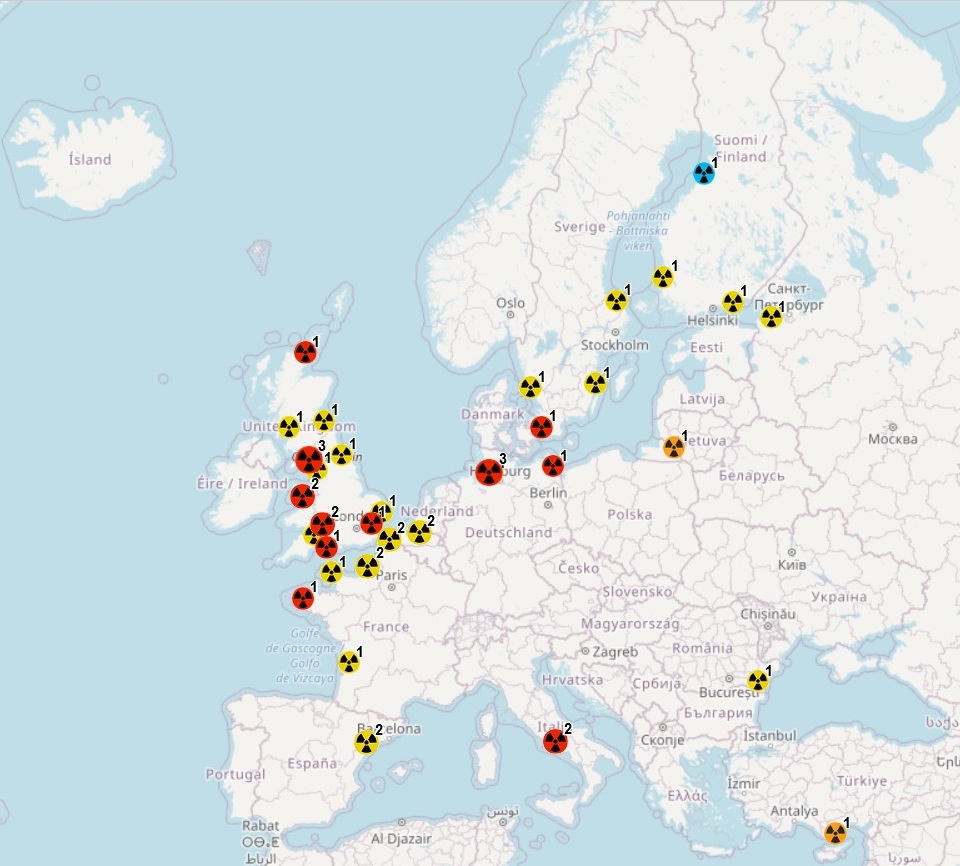EMODnet Human Activities, Nuclear Power Plants
The geodatabase on coastal Nuclear Power Plants was created in 2019 by Cogea for the European Marine Observation and Data Network (EMODnet). It is the result of the aggregation and harmonization of datasets provided by several EU and non-EU sources. It is available for viewing and download on the EMODnet Human Activities web portal ( https://emodnet.ec.europa.eu/en/human-activities). The geodatabase contains points representing nuclear power plants sites in the following countries: Belgium, Finland, France, Germany, Italy, Netherlands, Romania, Russia, Spain, Sweden, Turkey and UK. Where available each point has the following attributes: EMODnet Code, Plant Name, Country, Status (Operational, Permanently shut down, Planned, Under construction), Number of Reactors, Thermal Capacity (MW), Gross Capacity (MW), Net Capacity (MW), Location (Municipality), Water Source, Latitude, Longitude. Additional informations about reactors are stored in a separated table and are related to the point feature class. Where available for each reactor the following attributes are reported: EMODnet Code, Plant Name, Status (Operational, Permanently shut down, Planned, Under construction), Type, Model, Fuel Type, Thermal Capacity (MW), Gross Capacity (MW), Net Capacity (MW), Operator, Nuclear Steam Supply System (NSSS), Construction Year, Construction Month, Criticality Year, Criticality Month, Connection to the Grid Year, Connection to the Grid Month, Shut Down Year, Shut Down Month. The dataset will be updated every year.
Simple
- Date (Publication)
- 2019-03-29
- Date (Revision)
- 2019-03-29
- Date (Creation)
- 2019-03-29
- Citation identifier
- EMODnet_HA_Nuclear_Plants_20190329
- Point of contact
-
Organisation name Individual name Electronic mail address Role Cogea Srl
Author World Energy Council
Resource provider Open Power System Data
Resource provider World Nuclear Association
Resource provider International Atomic Energy Agency, Power Reactor information System
Resource provider Global Energy Observatory
Resource provider
-
GEMET - INSPIRE themes, version 1.0
-
-
Energy resources
-
Area management/restriction/regulation zones and reporting units
-
-
GEMET - Themes, version 2.4
-
-
energy
-
-
GEMET - Concepts, version 3.1
-
-
non-renewable energy resource
-
-
GEMET (version 3.1, 2012-07-20)
-
-
nuclear power plant
-
nuclear reactor
-
- Spatial representation type
- Vector
- Denominator
- 100000
- Language
- English
- Topic category
-
- Utilities communication
))
- Access constraints
- Other restrictions
- Other constraints
- No limitations on public access
- gmd:useconstraints
- otherRestrictions
- Other constraints
-
Creative Commons CC-BY 4.0 https://creativecommons.org/licenses/by/4.0/
- gmd:useconstraints
- otherRestrictions
- Other constraints
-
This data was downloaded from the EMODnet Portal ( https://emodnet.ec.europa.eu/en/). The data originator is Cogea Srl.
- Reference system identifier
- EPSG:4326
- Reference system identifier
- ISO 19108 calendar
- Transfer size
- 0
- OnLine resource
-
Protocol Linkage Name WWW:LINK
https://emodnet.ec.europa.eu/en/human-activities EMODnet Human Activities
WWW:DOWNLOAD
https://ows.emodnet-humanactivities.eu/geonetwork/srv/api/records/9a095778-75a1-45fc-a458-bb0b2ff8e412/attachments/EMODnet_HA_Nuclear_Plants_20190329.zip EMODnet_HA_Nuclear_Plants_20190329.zip
OGC:WMS
https://ows.emodnet-humanactivities.eu/wms? nuclear
OGC:WFS
https://ows.emodnet-humanactivities.eu/wfs? emodnet:nuclear
- Distribution format
-
Name Version Esri geodatabase gco:nilReason="unknown"> Esri shapefile gco:nilReason="unknown">
- Hierarchy level
- Dataset
Conformance result
- Date (Publication)
- 2008-12-04
- Explanation
-
See the referenced specification
- Pass
- Yes
Conformance result
- Date (Publication)
- 2010-12-08
- Explanation
-
See the referenced specification
Conformance result
- Date (Publication)
- 2009-12-15
- Explanation
-
See the referenced specification
- Pass
- Yes
- Statement
-
Data were retrived from multiple sources. Validation and quality assurance remain up to primary data sources, while harmonization is carried out by Cogea. The harmonisation process consisted of identifying a set of attributes common to all the different datasets, thus creating a single data model. To do so, it was necessary to define a homogenous set of variables for each attribute. Therefore, raw data attributes may use a different terminology, although the information contained remains basically the same. For further information on validation and quality assurance, it is suggested that primary data sources are contacted. Generally speaking data are to be considered very reliable, because they come from official sources in charge of data collection.
Metadata
- File identifier
- 9a095778-75a1-45fc-a458-bb0b2ff8e412 XML
- Metadata language
- English
- Character set
- UTF8
- Hierarchy level
- Dataset
- Date stamp
- 2025-08-29T09:53:13.534695Z
- Metadata standard name
-
ISO19115
- Metadata standard version
-
2003/Cor.1:2006
- Metadata author
-
Organisation name Individual name Electronic mail address Role Cogea Srl
Point of contact
Overviews

Spatial extent
))
Provided by
